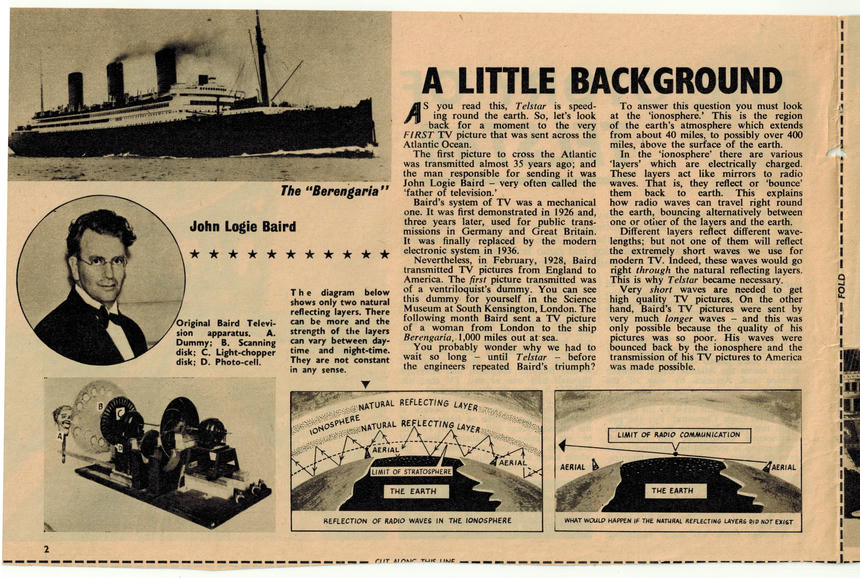Scrapbook 3: The Story of Telstar (2)

A LITTLE BACKGROUND
AS you read this, Telstar is speeding round the earth. So, let’s look back for a moment to the very FIRST TV picture that was sent across the Atlantic Ocean.
The first picture to cross the Atlantic was transmitted almost 35 years ago; and the man responsible for sending it was John Logie Baird — very often called the ‘father of television.’
Baird’s system of TV was a mechanical one. It was first demonstrated in 1926 and, three years later, used for public transmissions in Germany and Great Britain. It was finally replaced by the modern electronic system in 1936.
Nevertheless, in February, 1928, Baird transmitted TV pictures from England to America. The first picture transmitted was of a ventriloquist’s dummy. You can see this dummy for yourself in the Science Museum at South Kensington, London. The following month Baird sent a TV picture of a woman from London to the ship Berengaria, 1,000 miles out at sea.
You probably wonder why we had to wait so long — until Telstar — before the engineers repeated Baird’s triumph?
To answer this question you must look at the ‘ionosphere.’ This is the region of the earth’s atmosphere which extends from about 40 miles, to possibly over 400 miles, above the surface of the earth.
In the ‘ionosphere’ there are various ‘layers’ which are electrically charged. These layers act like mirrors to radio waves. That is, they reflect or ‘bounce’ them back to earth. This explains how radio waves can travel right round the earth, bouncing alternatively between one or other of the layers and the earth.
Different layers reflect different wavelengths; but not one of them will reflect the extremely short waves we use for modern TV. Indeed, these waves would go right through the natural reflecting layers. This is why Telstar became necessary.
Very short waves are needed to get high quality TV pictures. On the other hand, Baird’s TV pictures were sent by very much longer waves — and this was only possible because the quality of his pictures was so poor. His waves were bounced back by the ionosphere and the transmission of his TV pictures to America was made possible.
Original Baird Television apparatus. A. Dummy; B. Scanning disk; C. Light-chopper disk; D. Photo-cell.
The diagram below shows only two natural reflecting layers. There can be more and the strength of the layers can vary between daytime and night-time. They are not constant in any sense.